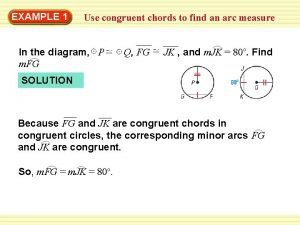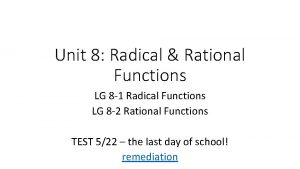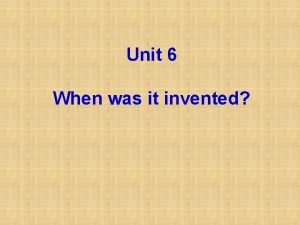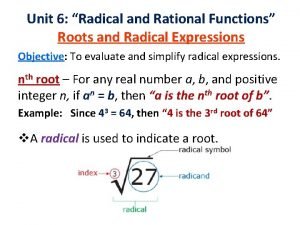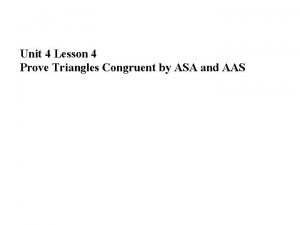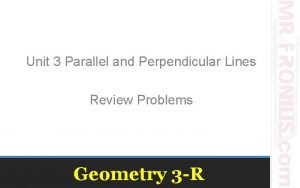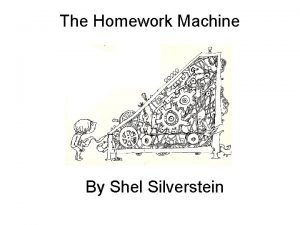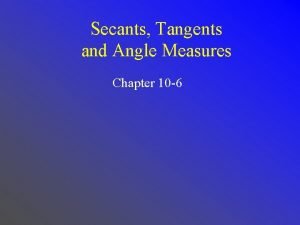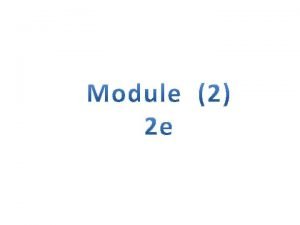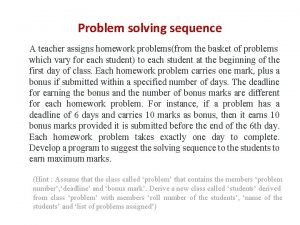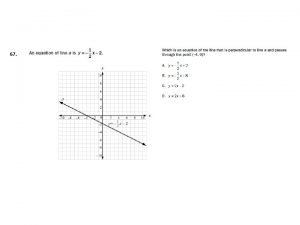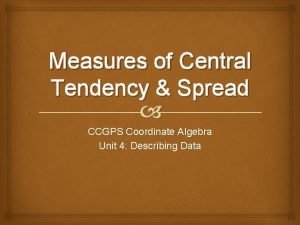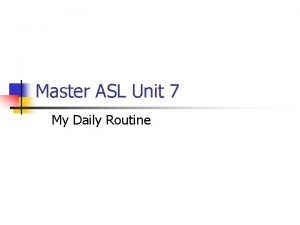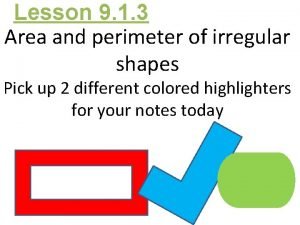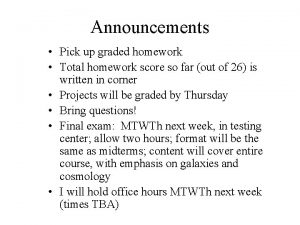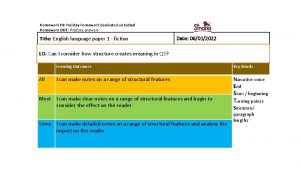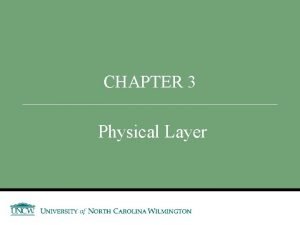Announcements n Homework n Chapter 4 n n













































![EXAMPLE: Separate Iron and Magnesium? Ksp = [Fe+3][OH-]3 = 2 X 10 -39 Ksp EXAMPLE: Separate Iron and Magnesium? Ksp = [Fe+3][OH-]3 = 2 X 10 -39 Ksp](https://slidetodoc.com/presentation_image_h/b170bbedf36d1025ac7f07f103951a6d/image-46.jpg)
![EXAMPLE: Separate Iron and Magnesium? Ksp = [Fe+3][OH-]3 = 2 X 10 -39 Ksp EXAMPLE: Separate Iron and Magnesium? Ksp = [Fe+3][OH-]3 = 2 X 10 -39 Ksp](https://slidetodoc.com/presentation_image_h/b170bbedf36d1025ac7f07f103951a6d/image-47.jpg)
![EXAMPLE: Separate Iron and Magnesium? Ksp = [Fe+3][OH-]3 = 2 X 10 -39 (1. EXAMPLE: Separate Iron and Magnesium? Ksp = [Fe+3][OH-]3 = 2 X 10 -39 (1.](https://slidetodoc.com/presentation_image_h/b170bbedf36d1025ac7f07f103951a6d/image-48.jpg)


![EXAMPLE: Separate Iron and Magnesium? Ksp = [Fe+3][OH-]3 = 2 X 10 -39 (1. EXAMPLE: Separate Iron and Magnesium? Ksp = [Fe+3][OH-]3 = 2 X 10 -39 (1.](https://slidetodoc.com/presentation_image_h/b170bbedf36d1025ac7f07f103951a6d/image-51.jpg)
![EXAMPLE: Separate Iron and Magnesium? What [OH-] is required to begin the precipitation of EXAMPLE: Separate Iron and Magnesium? What [OH-] is required to begin the precipitation of](https://slidetodoc.com/presentation_image_h/b170bbedf36d1025ac7f07f103951a6d/image-52.jpg)
![EXAMPLE: Separate Iron and Magnesium? @ equilibrium [OH-] to ‘completely’ remove Fe 3+ ^ EXAMPLE: Separate Iron and Magnesium? @ equilibrium [OH-] to ‘completely’ remove Fe 3+ ^](https://slidetodoc.com/presentation_image_h/b170bbedf36d1025ac7f07f103951a6d/image-53.jpg)
- Slides: 53

Announcements n Homework – n Chapter 4 n n 8, 11, 13, 17, 19, 22 Chapter 6 n 6, 9, 14, 15 n Exam n Thursday

4 -8 n Meaning of Confidence interval? n Is an interval around the experimental mean that most likely contains the true mean (m).

Homework 4. 11

Question 4 -13. A trainee in a medical lab will be released to work on her own when her results agree with those of an experienced worker at the 95% confidence interval. Results for a blood urea nitrogen analysis are shown …. a) What does abbreviation d. L refer to? d. L = deciliter = 0. 1 L = 100 m. L b) Should the trainee work alone?

Comparison of Means with Student’s t Is there a significant difference? First you must ask, is there a significant difference in their standard deviations? NO YES f-test

4 -13. d. L = deciliter = 0. 1 L = 100 m. L Ftable = 6. 26 Find spooled and t No difference

ttable = 2. 262 No significant difference between two workers … Therefore trainee should be “Released”

Homework 4 -17. If you measure a quantity four times and the standard deviation is 1. 0 % of the average, can you be 90 % confident that the true value is within 1. 2% of the measured average Yes

Homework 4 -19. Hydrocarbons in the cab of an automobile … Do the results differ at 95% CL? 99% CL? Ftable ~ 1. 84 Find spooled and t No Difference

Homework The table gives t for 60 degrees of freedom, which is close to 62. ttable = 1. 671 and 2. 000 at the 90 and 95% CL, respectively. The difference IS significant at both confidence levels.

n 4 -22. Q-test, Is 216 rejectable? n 192, 216, 202, 195, 204 Qtable = 0. 64 Retain the “outlier” 216

Chapter 6 Chemical Equilibrium

Chemical Equilibrium n n Equilibrium Constant Equilibrium and Thermodynamics n n n n Enthalpy Entropy Free Energy Le Chatelier’s Principle Solubility product (Ksp) Common Ion Effect Separation by precipitation Complex formation

Example The equilibrium constant for the reaction -14 + K = 1. 0 x 10 H 2 O H + OH w NH 3 + H 2 O NH 4+ + OH- KNH 3 = 1. 8 x 10 -5 Find the Equilibrium constant for the following reaction NH 4+ NH 3 + H+ K 3 = ?

Equilibrium and Thermodynamics A brief review …

Equilibrium and Thermodynamics enthalpy => H enthalpy change => DH exothermic vs. endothermic entropy => S free energy Gibbs free energy => G Gibbs free energy change => DG

Equilibrium and Thermodynamics DGo = DHo - TDSo DGo = -RT ln (K) K = e-(DGo/RT)

Equilibrium and Thermodynamics n The case of HCl H+ + Cl- K=? DHo = -74. 83 x 103 J/mol DS 0 = -130. 4 k. J/mol DGo = DHo - TDSo DGo = (-74. 83 k. J/mol) – (298. 15 K) (-130. 4 k. J/mol) DGo = -35. 97 k. J/mol

Equilibrium and Thermodynamics n The case of HCl H+ + Cl- K=? DGo = (-74. 83 k. J/mol) – (298. 15 K) (-130. 4 k. J/mol) DGo = -35. 97 k. J/mol

Predicting the direction in which an equilibrium will initially move Le. Chatelier’s Principle and Reaction Quotient

Le Chatelier's Principle n n If a stress, such as a change in concentration, pressure, temperature, etc. , is applied to a system at equilibrium, the equilibrium will shift in such a way as to lessen the effect of the stress. Stresses – n n n Adding or removing reactants or products Changing system equilibrium temperature Changing pressure (depends on how the change is accomplished

Consider 6 CO 2 (g) + 6 H 2 O(g) C 6 H 12 O 6(s) + 6 O 2(g) Equilibrium moves Right Predict in which direction the equilibrium moves as a result of the following stress: Increasing [CO 2]

Consider 6 CO 2 (g) + 6 H 2 O(g) C 6 H 12 O 6(s) + 6 O 2(g) Equilibrium moves Left Predict in which direction the equilibrium moves as a result of the following stress: Increasing [O 2]

Consider 6 CO 2 (g) + 6 H 2 O(g) C 6 H 12 O 6(s) + 6 O 2(g) Equilibrium moves Left Predict in which direction the equilibrium moves as a result of the following stress: Decreasing [H 2 O]

Consider 6 CO 2 (g) + 6 H 2 O(g) C 6 H 12 O 6(s) + 6 O 2(g) NO CHANGE Predict in which direction the equilibrium moves as a result of the following stress: Removing C 6 H 12 O 6(s) K does not depend on concentration of solid C 6 H 12 O 6

Consider 6 CO 2 (g) + 6 H 2 O(g) C 6 H 12 O 6(s) + 6 O 2(g) Equilibrium moves Right Predict in which direction the equilibrium moves as a result of the following stress: Compressing the system System shifts towards the direction which occupies the smallest volume. Fewest moles of gas.

Consider 6 CO 2 (g) + 6 H 2 O(g) C 6 H 12 O 6(s) + 6 O 2(g) Equilibrium moves Right DH = + 2816 k. J Predict in which direction the equilibrium moves as a result of the following stress: Increasing system temperature System is endothermic … heat must go into the system (think of it as a reactant)

Consider this Co. Cl 2 (g) Co (g) + Cl 2(g) K=2. 19 x 10 -10 When [COCl 2] is 3. 5 x 10 -3 M, [CO] is 1. 1 x 10 -5 M, and [Cl 2] is 3. 25 x 10 -6 M is the system at equilibrium? Q= Reaction quotient

Compare Q and K Q = 1. 02 x 10 -8 K = 2. 19 x 10 -10 System is not at equilibrium, if it were the ratio would be 2. 19 x 10 -10 When Q>K TOO MUCH PRODUCT TO BE AT EQUILIRBIUM Equilibrium moves to the left Q<K TOO MUCH REACTANT TO BE AT EQUILIRBIUM Equilibrium moves to the Right Q=K System is at Equilibrium

Solubility Product Introduction to Ksp

Solubility Product solubility-product the product of the solubilities solubility-product constant => Ksp constant that is equal to the solubilities of the ions produced when a substance dissolves

Solubility Product In General: A x. B y <=> x. A+y + y. B-x [A+y]x [B-x]y K = ------[Ax. By] K = Ksp = [A+y]x [B-x]y

Solubility Product For silver sulfate Ag 2 SO 4 (s) <=> 2 Ag+(aq) + SO 4 -2(aq) Ksp = [Ag+]2[SO 4 -2]

Solubility of a Precipitate in Pure Water EXAMPLE: How many grams of Ag. Cl (fw = 143. 32) can be dissolved in 100. m. L of water at 25 o. C? Ag. Cl <=> Ag+ + Cl. Ksp = [Ag+][Cl-] = 1. 82 X 10 -10 (Appen. F) let x = molar solubility = [Ag+] = [Cl-]

EXAMPLE: How many grams of Ag. Cl (fw = 143. 32) can be dissolved in 100. m. L of water at 25 o. C? Ag. Cl(s) Initial Change Equilibrium Ag+ (aq) + Cl- (aq) Some - - -x -x +x +x (x)(x) = Ksp = [Ag+][Cl-] = 1. 82 X 10 -10 x = 1. 35 X 10 -5 M

EXAMPLE: How many grams of Ag. Cl (fw = 143. 32) can be dissolved in 100. m. L of water at 25 o. C? x = 1. 35 X 10 -5 M n How many grams is that in 100 ml? # grams = (M. W. ) (Volume) (Molarity) = 143. 32 g mol-1 (. 100 L) (1. 35 x 10 -5 mol L-1) = 1. 93 X 10 -4 g = 0. 193 mg

The Common Ion Effect

The Common Ion Effect common ion effect n a salt will be less soluble if one of its constituent ions is already present in the solution

The Common Ion Effect EXAMPLE: Calculate the molar solubility of Ag 2 CO 3 in a solution that is 0. 0200 M in Na 2 CO 3. Ag 2 CO 3 <=> 2 Ag+ + CO 3 -2 Ksp = [Ag+]2[CO 3 -2] = 8. 1 X 10 -12

EXAMPLE: Calculate the molar solubility of Ag 2 CO 3 in a solution that is 0. 0200 M in Na 2 CO 3. Ag 2 CO 3 <=> 2 Ag+ + CO 3 -2 Initial Change Equilibrium Solid - 0. 0200 M -x Solid +2 x +x 0. 0200+x Ksp = [Ag+]2[CO 3 -2] = 8. 1 X 10 -12 Ksp=(2 x)2(0. 0200 M + x) = 8. 1 X 10 -12 4 x 2(0. 0200 M + x) = 8. 1 X 10 -12

EXAMPLE: Calculate the molar solubility of Ag 2 CO 3 in a solution that is 0. 0200 M in Na 2 CO 3. 4 x 2(0. 0200 M + x) = 8. 1 X 10 -12 no exact solution to a 3 rd order equation, need to make some approximation first, assume the X is very small compared to 0. 0200 M 4 X 2(0. 0200 M) = 8. 1 X 10 -12 X= 1. 0 X 10 -5 M

EXAMPLE: Calculate the molar solubility of Ag 2 CO 3 in a solution that is 0. 0200 M in Na 2 CO 3. X = 1. 0 X 10 -5 M (1. 3 X 10 -4 M in pure water) Second check assumption [CO 3 -2] = 0. 0200 M + X ~ 0. 0200 M + 0. 00001 M ~ 0. 0200 M Assumption is ok!

Separation by Precipitation

Separation by Precipitation Complete separation can mean a lot … we should define complete. Complete means that the concentration of the less soluble material has decreased to 1 X 10 -6 M or lower before the more soluble material begins to precipitate

Separation by Precipitation EXAMPLE: Can Fe+3 and Mg+2 be separated quantitatively as hydroxides from a solution that is 0. 10 M in each cation? If the separation is possible, what range of OH- concentrations is permissible. Two competing reactions Fe(OH)3(s) Fe 3+ + 3 OH- Mg(OH)2(s) Mg 2+ + 2 OH-
![EXAMPLE Separate Iron and Magnesium Ksp Fe3OH3 2 X 10 39 Ksp EXAMPLE: Separate Iron and Magnesium? Ksp = [Fe+3][OH-]3 = 2 X 10 -39 Ksp](https://slidetodoc.com/presentation_image_h/b170bbedf36d1025ac7f07f103951a6d/image-46.jpg)
EXAMPLE: Separate Iron and Magnesium? Ksp = [Fe+3][OH-]3 = 2 X 10 -39 Ksp = [Mg+2][OH-]2 = 7. 1 X 10 -12 Assume quantitative separation requires that the concentration of the less soluble material to have decreased to < 1 X 10 -6 M before the more soluble material begins to precipitate.
![EXAMPLE Separate Iron and Magnesium Ksp Fe3OH3 2 X 10 39 Ksp EXAMPLE: Separate Iron and Magnesium? Ksp = [Fe+3][OH-]3 = 2 X 10 -39 Ksp](https://slidetodoc.com/presentation_image_h/b170bbedf36d1025ac7f07f103951a6d/image-47.jpg)
EXAMPLE: Separate Iron and Magnesium? Ksp = [Fe+3][OH-]3 = 2 X 10 -39 Ksp = [Mg+2][OH-]2 = 7. 1 X 10 -12 Assume [Fe+3] = 1. 0 X 10 -6 M What will be the [OH-] required to reduce the [Fe+3] to [Fe+3] = 1. 0 X 10 -6 M ? Ksp = [Fe+3][OH-]3 = 2 X 10 -39
![EXAMPLE Separate Iron and Magnesium Ksp Fe3OH3 2 X 10 39 1 EXAMPLE: Separate Iron and Magnesium? Ksp = [Fe+3][OH-]3 = 2 X 10 -39 (1.](https://slidetodoc.com/presentation_image_h/b170bbedf36d1025ac7f07f103951a6d/image-48.jpg)
EXAMPLE: Separate Iron and Magnesium? Ksp = [Fe+3][OH-]3 = 2 X 10 -39 (1. 0 X 10 -6 M)*[OH-]3 = 2 X 10 -39

Add OH- Mg 2+ Fe 3+ 3+ Fe 2+ Mg Mg 2+ Fe 3+ 3+ Fe 3+ Mg 2+ 2+ Fe Mg Fe 3+ Mg 2+ 2+ Mg Fe 3+

Mg 2+ Mg 2+ Mg 2+ 2+ Mg 2+ Fe 3+ @ equilibrium What is the [OH-] when ^ this happens Is this [OH-] (that is in solution) great enough to start precipitating Mg 2+? Fe(OH)3(s)
![EXAMPLE Separate Iron and Magnesium Ksp Fe3OH3 2 X 10 39 1 EXAMPLE: Separate Iron and Magnesium? Ksp = [Fe+3][OH-]3 = 2 X 10 -39 (1.](https://slidetodoc.com/presentation_image_h/b170bbedf36d1025ac7f07f103951a6d/image-51.jpg)
EXAMPLE: Separate Iron and Magnesium? Ksp = [Fe+3][OH-]3 = 2 X 10 -39 (1. 0 X 10 -6 M)*[OH-]3 = 2 X 10 -39
![EXAMPLE Separate Iron and Magnesium What OH is required to begin the precipitation of EXAMPLE: Separate Iron and Magnesium? What [OH-] is required to begin the precipitation of](https://slidetodoc.com/presentation_image_h/b170bbedf36d1025ac7f07f103951a6d/image-52.jpg)
EXAMPLE: Separate Iron and Magnesium? What [OH-] is required to begin the precipitation of Mg(OH)2? [Mg+2] = 0. 10 M Ksp = (0. 10 M)[OH-]2 = 7. 1 X 10 -12 [OH-] = 8. 4 X 10 -6 M
![EXAMPLE Separate Iron and Magnesium equilibrium OH to completely remove Fe 3 EXAMPLE: Separate Iron and Magnesium? @ equilibrium [OH-] to ‘completely’ remove Fe 3+ ^](https://slidetodoc.com/presentation_image_h/b170bbedf36d1025ac7f07f103951a6d/image-53.jpg)
EXAMPLE: Separate Iron and Magnesium? @ equilibrium [OH-] to ‘completely’ remove Fe 3+ ^ -11 = 1. 3 X 10 M [OH-] to start removing Mg 2+ = 8. 4 X 10 -6 M “All” of the Iron will be precipitated b/f any of the magnesium starts to precipitate!!
 Pvu announcement
Pvu announcement R/announcements
R/announcements Church announcements
Church announcements Fahrenheit 451 part 3 test
Fahrenheit 451 part 3 test Potentiial
Potentiial General announcements
General announcements Jack prelutsky homework oh homework
Jack prelutsky homework oh homework Homework oh homework i hate you you stink
Homework oh homework i hate you you stink Parts of a poem
Parts of a poem Homework oh homework jack prelutsky
Homework oh homework jack prelutsky Alitteration definition
Alitteration definition Literal and figurative language
Literal and figurative language Geometry chapter 7 homework answers
Geometry chapter 7 homework answers Chapter 4 homework accounting
Chapter 4 homework accounting Yesterday's homework
Yesterday's homework Blank until you finish your homework
Blank until you finish your homework Homework 3 multiplying binomials and trinomials
Homework 3 multiplying binomials and trinomials Homework 4 congruent chords and arcs
Homework 4 congruent chords and arcs Unit 8 rational functions homework 1
Unit 8 rational functions homework 1 Who tf invented homework
Who tf invented homework Unit 6 radical functions homework 3
Unit 6 radical functions homework 3 Unit 5: polynomial functions homework 2
Unit 5: polynomial functions homework 2 How to prove triangles are congruent
How to prove triangles are congruent Unit 3 parallel and perpendicular lines
Unit 3 parallel and perpendicular lines Type of homework
Type of homework Two way tables homework 5
Two way tables homework 5 Shel silverstein poem homework machine
Shel silverstein poem homework machine Main idea 2 being a clown answer key
Main idea 2 being a clown answer key Take out your homework
Take out your homework Spellings for class 3
Spellings for class 3 Rationalize radicals worksheet
Rationalize radicals worksheet Macbeth homework
Macbeth homework Tangents secants and angle measures
Tangents secants and angle measures 8-2 special right triangles answer key
8-2 special right triangles answer key How often do you answer your homework
How often do you answer your homework A teacher assigns a score from 1 to 4
A teacher assigns a score from 1 to 4 How to tell if two events are independent
How to tell if two events are independent Chemistry online homework
Chemistry online homework Central tendency and spread homework
Central tendency and spread homework Master asl unit 7
Master asl unit 7 Area and perimeter grade 9
Area and perimeter grade 9 Conduct grades chart
Conduct grades chart Asl if only i could fly
Asl if only i could fly Signing naturally 5:5
Signing naturally 5:5 3:15 asking what is the sign
3:15 asking what is the sign 3.8 how many of what asl
3.8 how many of what asl Minidialogues
Minidialogues Signing naturally 5:8 homework
Signing naturally 5:8 homework The elevator incident by melinda
The elevator incident by melinda Write an email to a teacher
Write an email to a teacher My maths.co uk
My maths.co uk Purpose of homework
Purpose of homework Homework
Homework Assuaged definition to kill a mockingbird
Assuaged definition to kill a mockingbird

















